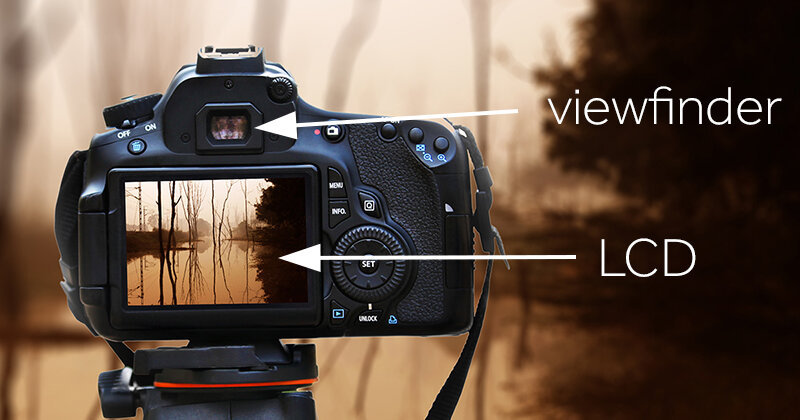What is "Live View" on your camera?
Most cameras have two methods of showing you what the final photo will look like: you can look through the viewfinder or you can see on the back of the camera on the LCD screen:
Some cameras only have the LCD option.
Optical vs electronic
Live view is an electronic version of what the camera is seeing. The camera takes the view captured by the sensor and transmits it to you live, either via the LCD or via the viewfinder if you have an electronic viewfinder.
All mirrorless cameras use an electronic viewfinder.
DSLRs still use optical viewfinders. With an optical viewfinder you are looking at the exact same thing the lens is looking at; it is not filtered via the sensor. There is a mirror insider your DSLR that reflects the scene up through the viewfinder like a periscope. The mirror flips up when you fire the shutter. (This is why mirrorless cameras are called that; they don’t have the mirror.)
Some people notice a lag in older mirrorless electronic viewfinders and prefer optical viewfinders for the instant view. This is becoming less noticeable as mirrorless cameras improve and is imperceptable in recent models.
Should you use live view?
It comes down to personal preference. I find I compose more easily using the viewfinder because that’s how I learnt photography (on a film camera with no live view).
Bright conditions
If you are shooting in bright sunshine you may find the live view isn’t bright enough for you to see what you are doing. Before you give up on it check whether you have the option to turn up the brightness of the screen. If you do adjust the brightness don’t forget to dial it down again once the sun goes in otherwise you may find you are under-exposing all your images thinking they are brighter than they really are (use the histogram to check if in doubt).
Difficult viewpoints
If your camera is on a tripod, or you are shooting very low or very high, using live view is often easier than trying to get your eye up to the viewfinder. If your camera has an articulating LCD screen it can make it even easier to tilt and save you cricking your neck.
Macro and DoF preview
Because live view is “what the sensor sees” you can preview what effect aperture changes are having on your depth of field more easily than using the depth of field preview button (which also tends to darken the preview if using smaller apertures). This is especially useful with macro when small changes have more noticeable effects.
ND filters
Similarly, using live view means you can check your exposure after taking into account any neutral density filters you have added in front of the lens. An optical viewfinder doesn’t show the decreased exposure. You should note that there is a limit to how useful this feature is; once you start using a 10- or 15-stop filter you may find live view is completely black.
Better focus
You can zoom in and check your focus when using live view, an option not available when using the viewfinder. This is especially useful for night photographers who can check they have a accurately focussed on a star or the moon.
Some cameras have the option for you to select your focus point using the touchscreen facility of your LCD. Check your settings for this one. You may prefer to select the focus only via the screen rather then “select focus and fire shutter” all in one touch (I find I often accidentally fire the shutter with my nose and prefer to stick to using the shutter button to take the photo).
Overlays
You may find the various overlay options in live view helpful. Turning them on is usually via a button press and then you have to cycle through the options to find the one you want. Check your camera manual to see what is available and whether they are also an option for the viewfinder:
spirit level
histogram
grid view
EXIF data
Eyesight
If you wear glasses you may not know you can adjust the magnification in the viewfinder via a dioptre wheel. Some people prefer this than dealing with varifocals or reading glasses that may be needed with the distance involved with live view.
Watch the battery levels
Live view uses a lot more battery power and you will find your batteries draining quicker than normal.
Damage to your sensor
If you are pointing your camera directly at the sun it’s possible that the sensor can be damaged if you are using live view.
Learn photography online
Emma’s online photography course for complete beginners is free by email. Join here and get started today:
You might also enjoy:




